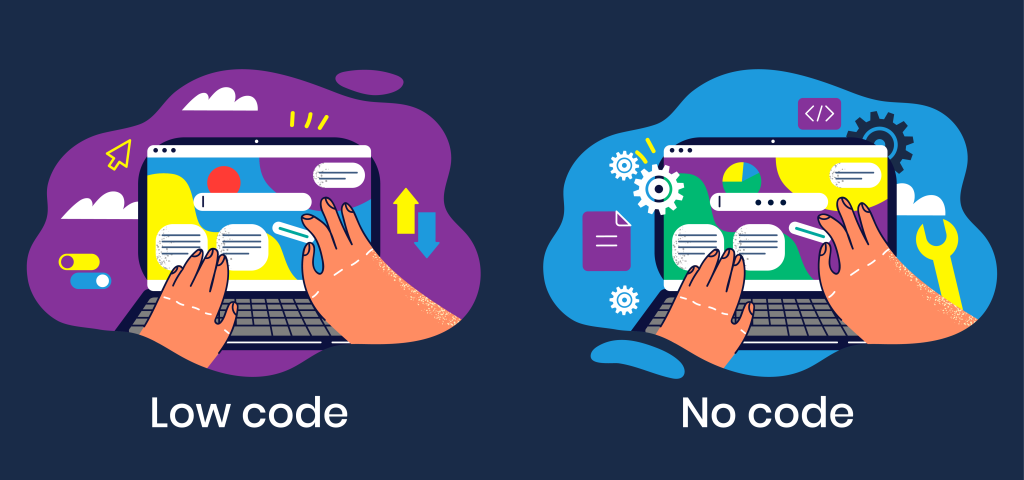Democratizing Software Development: The Rise Of Low-Code/No-Code
Techies
Democratizing Software Development: The Rise Of Low-Code/No-Code
Low-Code/ No-code platforms have revolutionized the way applications are developed, allowing multiple stakeholders, with little to no coding knowledge at all, to participate in the process and streamline development.
Code is a magical language that can make machines do your bidding. Just like a spell, a few lines of code can turn a pile of metal and plastic into a smart device that can send emails, play music, or even order pizza. However, mastering code requires a tremendous amount of dedication and skill.
Besides, have you ever tried to read code and felt like you were staring at hieroglyphics? Or worse, have you ever written code and felt like you were solving a Rubik’s cube blindfolded? If so, you are not alone.
An increasing number of software enthusiasts are turning to low-code/no-code (LCNC) platforms as a way to bypass the complexity of traditional programming. Instead of writing thousands of lines of codes, LCNC platforms offer a visual interface that lets you drag-and-drop pre-built components, connect them with logic flows, and voila! You now have a working app, website, or platform with little to no code at all.
Demystifying Low-code/No-code
Low-code/No-code platforms have been around for longer than you may think, although they were not always classified as such. The origin of LCNC springs from rapid application development (RAD) tools and visual programming languages that rose to prominence in the early 2000s. Fast forward to the mid-2010s, research giants Forrester, in an effort to categorize the back-then-new easy-to-use development platforms, came up with the label low-code.
A few years later, with the rise of digital transformation, the term low-code/no-code has gone full-on mainstream and now exclusively refers to visual development platforms that allow software solutions to be built with minimal to no coding knowledge.
Nowadays, LCNC platforms are gaining a lot of traction and momentum in business environments across a multitude of industries, while not showing signs of slowing down anytime soon.
According to a recent forecast conducted by Gartner, the market value for low code development technologies is expected to amount to $26.9 billion in 2023, achieving a whopping increase of 19.6% compared to the previous year.
Low-code vs No-code

While low-code and no-code platforms share some similarities, discernible nuances distinguish one from the other. Low-code platforms still require some coding, albeit minimal, whereas no-code platforms entirely circumvent the need for coding. Low-code platforms are typically used by businesses and organizations that need to create custom applications quickly, but still want some degree of control over the development process. No-code platforms, on the other hand, are more suited for individuals and small teams who want to build custom software applications without the need of technical expertise and the traditional obstacles associated with in-house software development. Ultimately, the choice between low-code and no-code platforms will depend on your specific needs and the resources available to you.
How does Low-code/No-code work?
With their easy-to-navigate interfaces and practical components, low-code/no-code platforms provide users of all levels with the opportunity to delve into the world of software development and start building different types of applications right away. Some of the most defining properties of LCNC platforms include:
- Visual interfaces: Drag-and-drop interfaces that allow users to design custom applications visually, without the need for coding.
- Pre-built components: Ready-made elements, such as UI components and database integrations, that can be combined to create custom applications quickly and easily.
- Templates: Pre-designed app templates that serve as a starting point for building custom applications. Templates can be modified to fit specific requirements.
- Backend integrations: Real-time integrations with various backend systems, such as databases and APIs, to ensure seamless communication between different software components.
- Collaboration tools: Features that facilitate team collaboration and project management, such as role-based access, commenting, and version control.
- Analytics and reporting: Tools that provide insights into app usage, user behavior, and other key metrics to help improve software performance and user experience.
- Security and compliance: Built-in security features and compliance controls to ensure that custom applications meet industry standards and regulations.
10 benefits of using low-code/no-code
The use of low-code/no-code platforms for software development has surged in popularity in recent years, thanks to their user-friendly and accessible nature. Below, we’ve compiled a list of ten advantages of using such platforms to build custom applications:
Speed
Develop custom applications quickly using drag-and-drop tools, pre-built components, and visual interfaces, which enable you to build complex applications faster than traditional software development.
Cost
Reduce the cost of software development significantly by leveraging low-code/no-code platforms, which eliminates the need for hiring developers, thus lowering the overall budget of the project.
Accessibility
Democratize software development by enabling users to build custom software applications using low-code/no-code platforms, regardless of their technical background, making it possible for more people to participate in the process.
Scalability
Easily scale applications as needed with drag-and-drop tools, pre-built components, and visual interfaces, enabling you to add new features, change workflows, and expand the application without significant amounts of coding.
Flexibility
Create a custom application that meets your specific needs, without the limitations of off-the-shelf software, offering more flexibility and control over your software solutions.
Integration
Seamlessly integrate your custom application with other software systems, such as CRM or ERP systems, using drag-and-drop tools and pre-built connectors, simplifying the integration process without custom coding.
Innovation
Experiment and test new ideas easily using drag-and-drop tools, pre-built components, and visual interfaces, enabling you to build prototypes quickly and iterate your application faster.
Collaboration
Collaborate with your team members using drag-and-drop tools, pre-built components, and visual interfaces, working on the same application simultaneously, improving the quality of the application while reducing development time.
Support
Access excellent support from most custom application platforms, including tutorials, training, and customer service, ensuring you have the resources you need to develop high-quality applications and overcome any challenges.
Futureproofing
Future-proof your custom application by leveraging drag-and-drop tools, pre-built components, and visual interfaces, which are designed to be updated and maintained over time, ensuring your application remains functional and relevant as technology continues to evolve.
8 of the most popular low-code/no-code platforms
Now that you’ve gained insight into the benefits and potential of low-code/no-code, you may be wondering which platforms are worth exploring. Here are some of the most popular LCNC platforms that can help you get started with building custom applications/websites quickly and easily:

- Airtable is a highly flexible low-code platform for developing custom applications. It empowers teams to create tailored workflows that streamline their business processes.
- Appian is a low-code platform that enables businesses to rapidly develop applications, including workflows, in order to meet their unique needs in an efficient and expedited manner.
- Microsoft Power Apps is a versatile low-code development platform that provides developers, CRM administrators, and business users with the ability to create native mobile and web applications by leveraging on-premise or cloud-based data sources.
- Salesforce Lightning is a no-code platform that simplifies development for business users, even those without programming experience, making it easy to streamline workflows and increase productivity.
- Webflow is an innovative platform that enables users to design fully-customized, professional websites without any coding knowledge. Its visual canvas allows for easy editing and customization.
- Bubble is a no-code platform for building SaaS platforms, marketplaces, and CRMs without writing a single line of code.
- Wappler is a powerful tool for designing and deploying applications without extensive coding knowledge. Its intuitive interface makes application design and deployment simple, even for users with minimal programming experience.
- Zapier is a cutting-edge platform that simplifies the process of creating workflows that transfer information across thousands of apps, without the need for coding expertise. Its visual builder allows users to create customized workflows with ease.
Low-code/no-code in development environments
Empowering collaboration: LCNC platforms have revolutionized the software development process, enabling non-technical users, known as citizen developers, to create and deploy sophisticated software with ease. Actually, the entire development process has become much simpler thanks to the user-friendly interfaces, templates, and drag-and-drop functionality offered by these platforms, allowing business stakeholders to easily participate in the development process and customize the solution to meet their specific business needs. This, in turn, allows for faster problem-solving, increased efficiency, and reduced reliance on IT departments, ultimately leading to greater agility and profitability.
Driving innovation: With the advent of LCNC platforms, business stakeholders can now focus on both ideation and development. This expedites experimentation, iteration, and implementation of ideas, reducing the need for lengthy development cycles. Such rapid prototyping enables businesses to outpace competition and meet customer demands swiftly. Moreover, citizen developers, being closely attuned to the business process, are well-equipped to identify improvement opportunities, implement solutions faster, and spearhead innovation within their organizations.
Agility and low-code/no-code
Low-code/no-code development platforms have transformed the way organizations operate, offering powerful tools to improve agility and streamline internal processes. LCNC platforms enable employees with minimal coding experience to create custom applications and workflows, freeing up valuable IT resources for more complex tasks. This translates to teams that can quickly respond to changing business requirements and overcome new challenges with ease.
Take the example of CME, a highly agile organization that uses LCNC to streamline internal complex tasks. Originally, CME faced the challenge of managing approvals and adding open-source libraries to their projects. But by implementing a LCNC Power Automate flow, CME was able to automate the approval process, ensuring that only approved libraries were added to their projects.
This process works by sending all requests for new libraries to the designated approver(s) for review. Once approved, the library is added to the list of approved libraries and can be used in any project. If the library is not approved, the requester is notified, and the library is not added. This low-code solution streamlines the approval process and reduces the risk of using unauthorized or unapproved libraries, all while being incredibly easy to use.
Wrapping up
Low-code/no-code platforms have ushered in a new era of software development, one that is more accessible, inclusive, and collaborative than ever before. With LCNC platforms, individuals with diverse backgrounds and skill levels can easily bring their ideas to life, and organizations can accelerate their innovation while reducing development costs and time-to-market. As such, LCNC platforms are not just transforming software development; they are paving the way for a future in which technology is more accessible and empowering for everyone.





